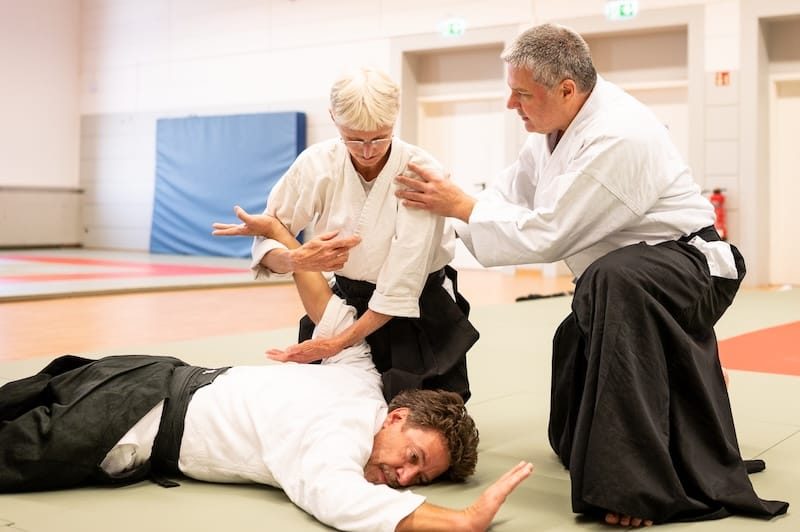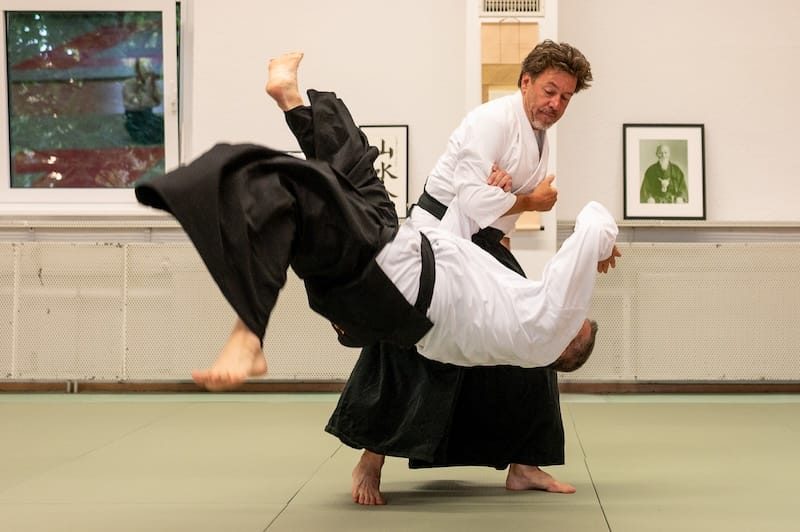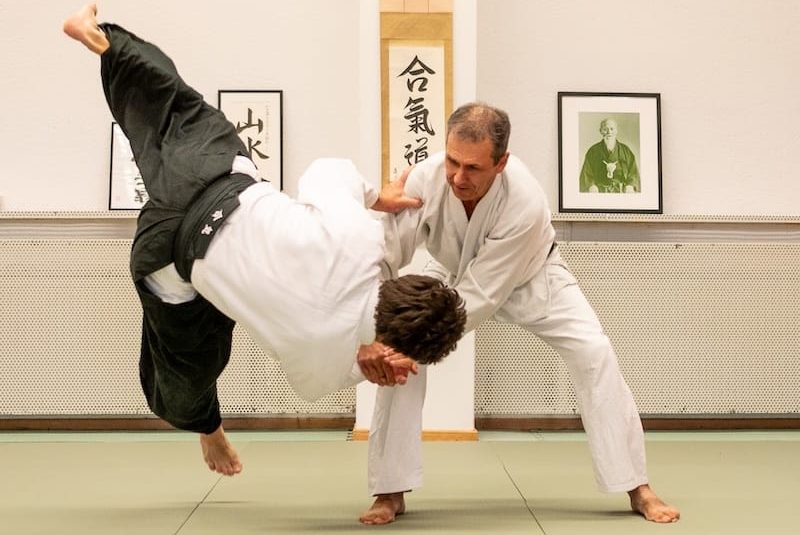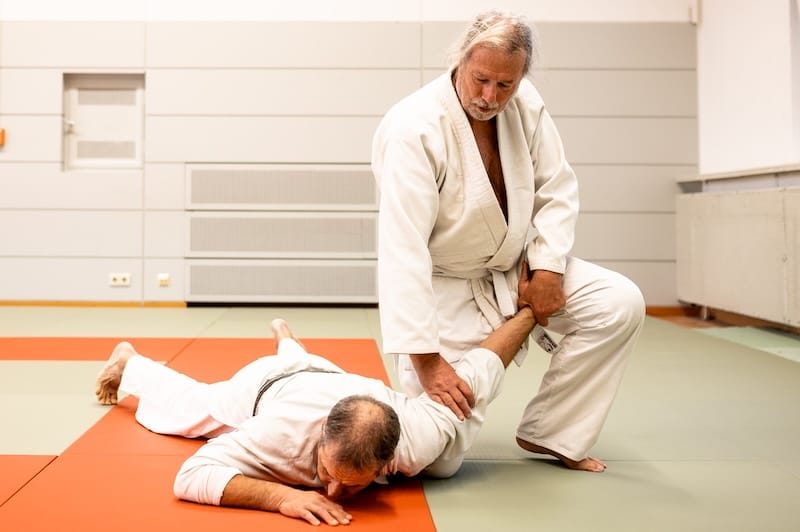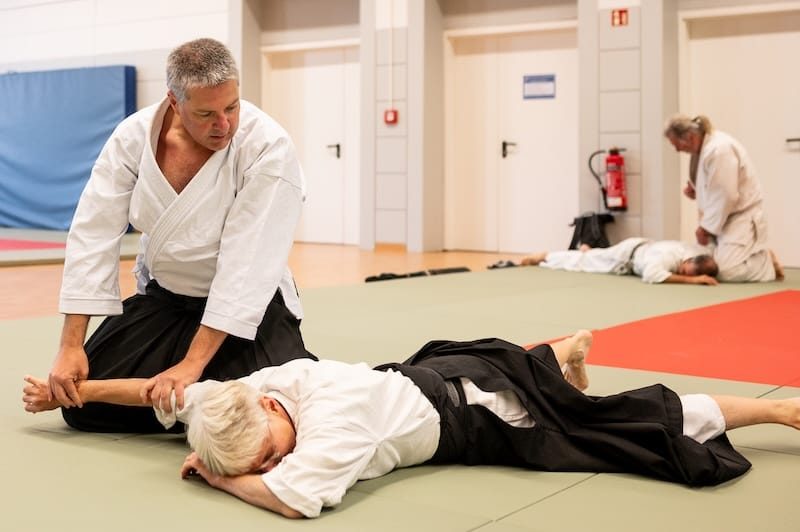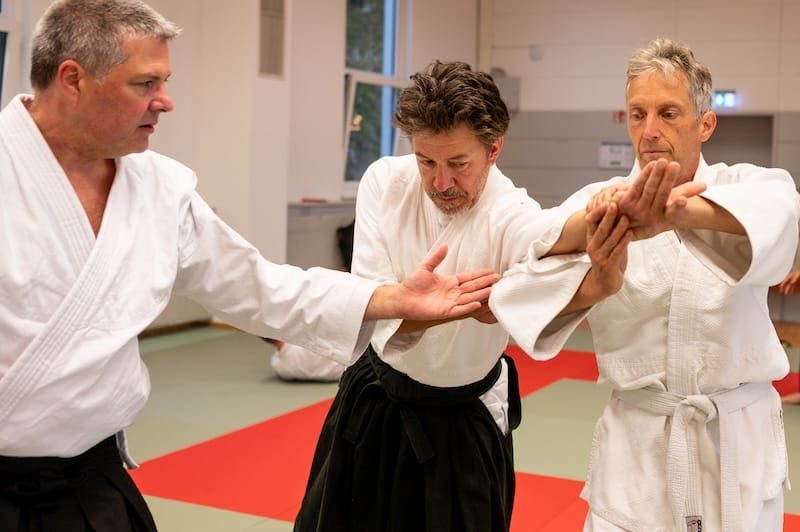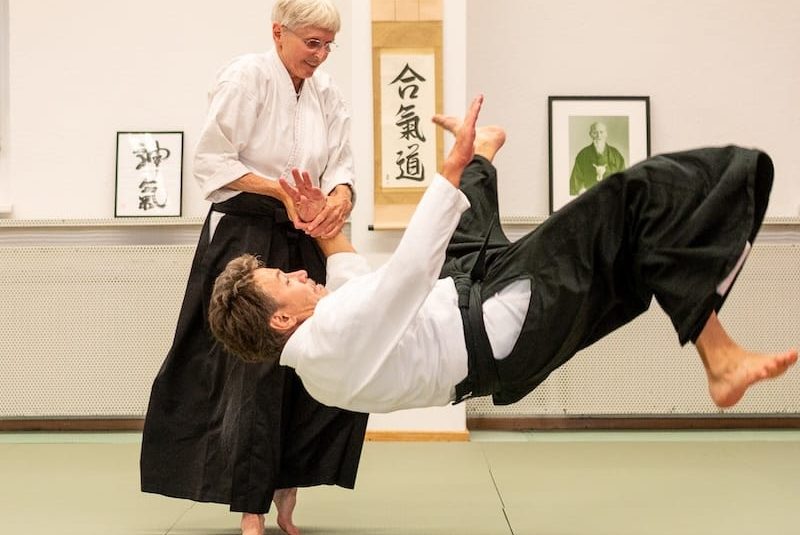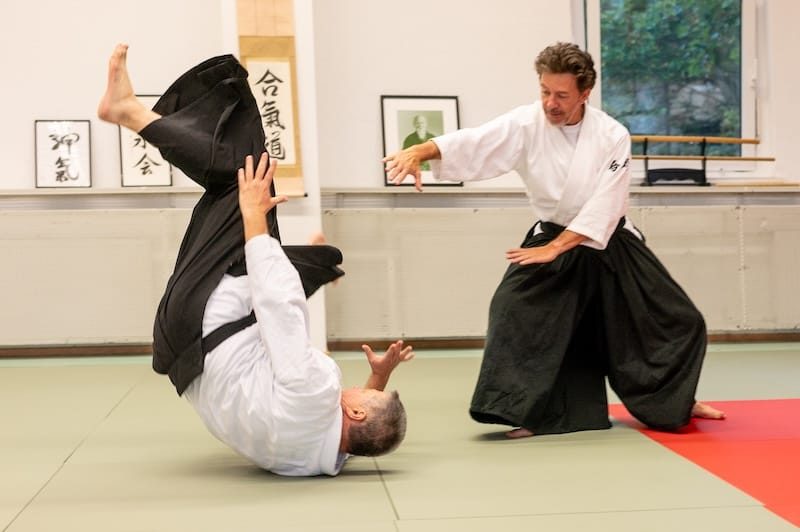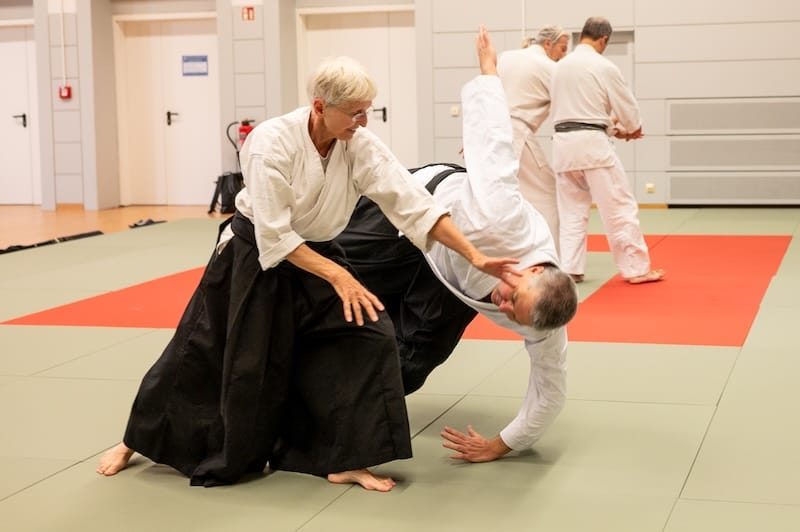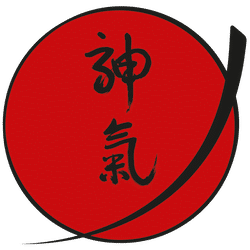!!! Do not change or delete this line - the submenu will be inserted here later !!!
Aikido - "The path of harmony and strength"
"Everyone has a mind that can be honed, a body that can be trained in some way, a path to follow."
Morihei Ueshiba (1883-1969)
The philosophy of Aikido (Contribution from Rita D.)
The philosophy of Aikido is based on the principle of harmony: instead of responding to violence with counter-violence, the energy of an attack is absorbed, redirected and neutralised. The aim is to control the attacker without harming them.
Respect, mindfulness and compassion take centre stage. Aikido teaches that true strength comes from inner calm and balance - and that external conflicts can only be resolved through inner clarity.
Harmonization over contention
Aikido is one of the lesser-known martial arts. Although its roots lie in sword fighting and self-defence, aikido is a defensive, peaceful sport. The aikidoka does not try to harm his attacker, but to neutralise the attack and control the situation.
Consequently, there are no tournaments, trophies or victories in this discipline. What appears easy at first glance is developed and perfected through years of training. Aikido is not a quick course in self-defence, acrobatic kung fu or pure meditation.
Experience self-awareness and community
In Aikido, everyone is both a teacher and a student. Although there are regular introductory courses for beginners, all dojo members train together. Aikido thrives on close dojo communities, co-operative training and the ethical claim: „the path of harmony and strength“.
How does this fit in with a martial art? The principle of aikido is to connect with the attacker's energy, redirect it and effectively disrupt „uke“, the attacking partner, by evading and unbalancing them. The aim is not to counter an attack with force, but to deflect it as gently as possible for both sides.
Who is Aikido suitable for?
Actually for almost everyone. Members aged between 12 and over 70 train in our dojo, some for three months, others for 40 years. Even as an adult, you can join or start again at any time. Everyone sets their own pace - there is no competition, winners or losers. In any case, the best success is the good feeling on the way home, somewhere between pleasant tiredness and anticipation of the next training session.
Aikido is one of the youngest Japanese martial arts and a non-violent budo discipline based on highly efficient defence techniques - a martial art that both protects the defender and preserves the integrity of the attacker.
Aikido is peaceful, effective and technically demanding. It promotes and challenges the whole person. There are no competitions or medals to be won. Despite this - or precisely because of this - more and more people are finding their way to this martial art, regardless of age and physical constitution, women and men alike.
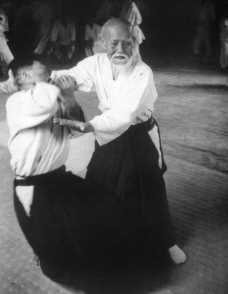
The founder of Aikido, O-Sensei (Grand Master) Morihei Ueshiba, was born on 14 December 1883 in Tanabe, Japan. He began practising Budo as early as 1893. He initially practised mainly the use of spear and sword, later adding various Ju-Jutsu styles.
The most important event was his meeting with the legendary master of Daito-Ryu, Sogaku Takeda, in 1911, from whom he later received the Menkyo-Kaiden (teaching authority) of Daito-Ryu.
Around 1919, O-Sensei met the monk Deguchi Onisaburo. The confrontation with his teachings and his own personal development caused Ueshiba to question the principles of his previous martial art.
As a soldier in the Russo-Japanese War, he had experienced death and destruction at a young age and recognised the futility of military action. His friendship with the monk and his spiritual teachings ultimately led to a break with his former teacher Sogaku Takeda in 1922.
In the following years, Ueshiba further developed and perfected his martial art into the form we know today. From 1942, he finally called it Aikido. Master Ueshiba died on 26 April 1969 in Iwama, Japan, at the age of 85.
The basic idea of Aikido techniques is to evade the linear force of an attack by means of a twisting movement and to redirect the attacker's movement into a circular movement. The attacker is thus thrown off balance and can then be thrown to the ground and pinned there.
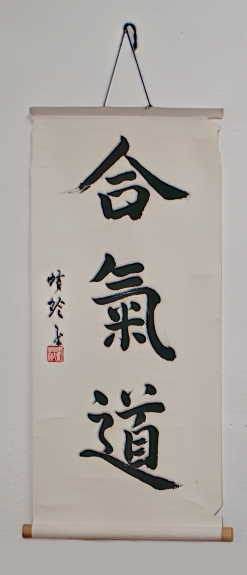
Ai (Harmony) - connect, unite, adapt
Harmony means not confronting the opponent's force head-on, but evading it and continuing the attacker's movement together.
Ki (force) - Spirit, energy, inner strength
Ki is not power in the usual sense of physical strength, but calmness of mind, strength of will and mindfulness. It enables you to recognise your opponent's energy in good time, avoid it and redirect it.
Do (way) - Path, development
On the one hand, it takes time for the various movement sequences to become second nature. On the other hand, constantly working on your own posture and movements - mindfully defending against an attack from your own centre - can lead to more composure in everyday life.
Do also means a path to yourself, to your own centre. This path is never finished.
For the first training sessions, you only need simple sportswear: long training trousers and preferably a long-sleeved T-shirt. Bathing shoes are also useful for the journey from the changing room to the dojo (training hall). Training is done barefoot; feet can be washed in the changing rooms before training.
After starting out, a Budo-Gi is the appropriate clothing. It consists of a jacket, trousers and a fabric belt. Advanced aikidoka can also wear a hakama - a traditional Japanese trouser skirt in black or dark blue.
While in other clubs this is only customary after the first master grade, in our club the trainer can authorise or recommend the wearing of the hakama after the first examination.
Buying tip: A conventional judo suit is usually suitable for Aikido, which is available from around 30 euros in specialised budo shops or online.
When you visit us for the first time:
Clothing and equipment - Wear comfortable, loose clothing such as jogging trousers and a T-shirt or a dogi (aikido suit) so that you can move freely during training. Use bathing shoes or Japanese zori to walk between the changing room and the dojo. In the dojo, place them on the edge of the tatami mats. Take all valuables with you into the dojo. You can leave your rucksack or bag on one of the benches.
Tradition and etiquette - We will show you the basic Aikido traditions and etiquette so that you can train safely and respectfully.
Procedure for your first training session
Warm up - We start with a warm-up programme to prepare the body and avoid injuries.
Basic techniques - You will learn basic techniques such as rolling, falling and simple throws.
Footwork - We practise the footwork and movements that play a central role in Aikido.
Relaxation and connection - You will learn how important it is to stay relaxed and follow your partner's movements.
What you should know
Regular training - Continuity is the key to progress. We encourage you to come regularly.
Patience - Aikido is demanding. Be patient with yourself - the learning process takes time, and that is completely normal.
Security - We observe clear safety rules to avoid injuries. Your health comes first.
The journey is the destination - Aikido is not about aggression, but about self-defence and harmonising with the energy of the attacker. Enjoy the path of learning and self-development.

Georg Umlauf
Shinki Rengo Aikido Dojo-Cho
5th Dan Aikido, Shidoin
Jun-Dairi-Kyoju 4th Dan Daitoryu
I came to Aikido through the wider world of sports. When I was young, I was interested in all kinds of sports, including martial arts. I made my debut in Karate before I discovered Aikido. Faced with the choice of continuing one or the other, I decided on Aikido. I was fascinated by the idea of sparing the integrity of the opponent even in the most violent confrontation. And I liked, and still like, the soft, flowing movements.
Over the years, I had to give up many a sport, but I continue to practise Aikido: as a challenge and a goal for myself to progress further, for the joy of movement, together with like-minded people. And to teach this way: to end conflicts in the most considerate way possible.

Rick Soriano
Aikido department head
6th Dan Aikido, Shidoin
4th Dan Daitoryu
I do Aikido because it is a moving meditation for me and helps me to concentrate fully on the moment. The past and future fade away - only the here and now really counts. Over the years, Aikido has helped me to deal better with everyday stress. I notice that I smile more often during training than I usually do in everyday life. And when I see others smiling, I think that they are experiencing small moments of clarity (satori).
My Aikido combines these teachings: solid fundamentals, sensitivity, adaptability, ethical intent and lifelong refinement. Each teacher has contributed in their own way to my understanding of Aikido as a path that unites body, mind and character.

Markus Krabel
PSV HD 1st Executive Board
5th Dan Aikido, Shidoin
3rd Dan Daitoryu
I began practising Aikido as a lively youngster because I was fascinated by its dynamic athleticism and simple beauty of form.
The intensive and holistic training has always positively accompanied my personal development, even outside of training - encouraging and challenging is a core element that I was able to experience in Aikido. The great community in every Aikido group I have trained with since then, and especially the various trainers, have always opened up new perspectives for me in Aikido and beyond. This makes Aikido an indispensable 'lifestyle' for me to this day.

Alejandro Gvirtz
3rd Dan Aikido, Fukushidoin
2nd Kyu Daitoryu
When I started with Aikido many years ago, I was very quickly enthusiastic about both the movements and the spiritual aspects of this (martial) art.
In training, we learn to move "harmoniously" so that conflicts can be avoided or defused. Conflicts with ourselves and with our partner. Respect for our partner is always part of this.
For me, it is a path of harmony, both physically and spiritually. You also try to seek, live and experience this harmony in your daily life: To avoid arguments, to be open to new things and to find joy in being with each other.
You never stop learning new things and having fun with movement. Whether new or familiar techniques: there are always new angles in the techniques.
That's why Aikido has been part of my life for several decades.

Karl Kiening
PSV HD 2nd Executive Board
Sansuikai Germany Dojo-Cho
2nd Dan Aikido
Zendo leader level 1 Daishin-Rinzai-Zen
3rd Kyu Muso Jikiden Eishin Ryu Iaido
5th Kyu Daitoryu
When I was looking to get back into sport shortly after my 51st birthday, I came across aikido purely by chance. Without any previous knowledge of other martial arts, I was thrilled from the very first moment, because what I experienced in training was so different to what I had previously experienced in sport: from the very first training session, Aikido showed me how to integrate body and mind, how to become "complete". This has not changed to this day, but has matured further. Aikido has simply become "mine" and, as an essential part of my life, I can no longer imagine life without it.

Claus Neuwirth
1st Dan Aikido
4th Kyu Daitoryu
Claus is the assistant instructor for beginners. His vast experience in Aikido helps beginners overcome obstacles and develop a deeper understanding of the Aikido techniques they need to know in order to build a firm and stable foundation for their progression in the Japanese art of Aikido. His calm nature and desire to help others is important to the development of our beginners and the future of our Aikido programme.
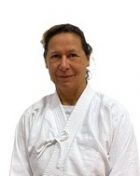
Heidi Kaschub
1st Dan Aikido
3rd Kyu Muso Jikiden Eishin Ryu Iaido
„Aikido is the art of harmony, of gaining control over your opponent without fighting“.
This quote from my Sensai Kosaku Takano in Japan describes Aikido as I feel it. We lived in Tokyo from 2004 to 2008, where I had the unique opportunity to get to know and love Aikido in its pure traditional form. It has stayed with me ever since.
Current information:
The Aikido training on 25.12.2025 is cancelled.
Aikido training will take place on 1 January 2026.
Visitors (non-members of PSV Heidelberg) - Aikidoka from outside the club are always welcome. We charge a small dojo fee per training session. You can purchase tickets for the Aikido training directly here on the website or via the QR code below. One ticket is valid for any training day.

Contact
Contact e-mail of the Aikido department
Would you like to receive news and information from the Aikido-Dojo of the PSV Heidelberg e.V.? Then simply write us an e-mail with the subject „Please add to the mailing list".
Location
PSV Heidelberg e.V. Budo Dojo
Elsa-Brandström-Strasse 8
69126 Heidelberg
Aikido - More than just martial arts!
Aikido is Japanese, elegant, effective - and much more than just sport. It keeps you flexible, strengthens your body and mind and brings you into contact with Japanese culture, language and meditation.
Are you over 18, 20, 30, 40, 50, 60 or 70? Perfect! Aikido is ideal for all ages - whether you're new to the sport or starting again after a break.
Now is the best time to try something new. Start your Aikido journey!
What does it cost? 6 weeks for only €40 (reduced rate €25). Your first trial lesson is free!
This is how it works: Sign up for your first trial training session: aikido.seminar@psv-hd.de
After the trial training you can book the 6-week course: polizeisportverein-heidelberg.de/courses
Let's go!
After your first Thursday lesson, you can also take part in Aikido training on Mondays (19.00-20.30) and Tuesdays (18.30-20.00).
New Aikido training for young people at PSV Heidelberg! Movement with purpose, concentration with energy and community without competition - every Tuesday from 17:00 to 18:30 in Südstadt.

Aikido at PSV Heidelberg - your moment to come down and become strong
Sometimes you need more than just sport.
Something that gets you out of your head - and gets you moving again.
Aikido is not a competition. No pressure.
It is about Balance, focus and movement with purpose.
You learn to move fluently, breathe calmly and stay clear - even when things get stressful.
Whether you are 12 or older: youth training at the Heidelberg Police Sports Club is your chance to try something new.
Community instead of competition. Concentration instead of chaos.
Tuesday, 17:00-18:30
Dojo of the Polizeisportverein Heidelberg e.V.
Research centre of the F&U schools, Elsa-Brandström-Str. 8, 69126 Heidelberg

Your trainers Markus Krabel and Heidi Kaschub accompany you with experience, patience and fun in training.
Safe, respectful, genuine - that's how Aikido works at PSV.
Just drop by.
Comfortable clothing is sufficient.
First trial training free of charge.
Registration for your young person's first trial training session & information: Markus Krabel
As soon as your child has completed the trial training and you have agreed with the youth coaches, you can book the 6-week course:
There are a number of different Aikido associations and organisations in Germany. Aikidoka from each of these different groups are equally welcome in our dojo.
Our instructors come from various traditions and conduct their classes accordingly. We feel enriched by this variety of approaches.
Aikido Sansuikai Germany
Some of our aikidokas also belong to a small group of aikido dojos in southern Germany and Switzerland. Sansuikai Europe originated from a group of students of Y. Yamada Shihan, who attended his seminars for years or liked to participate in the New York Aikikai (NYA) trained. Sansuikai International Europe was the United States Aikido Federation (USAF) and of the Aikikai Hombu Dojo in Tokyo. After the death of Yamada Sensei, Sansuikai groups can now join the Aikikai Hombu Dojo directly. Unfortunately, a European association is no longer recognised by the Aikikai Hombu Dojo in Tokyo; this is only possible on a country-by-country basis. The PSV Heidelberg Sansuikai Dojo has therefore joined Sansuikai Germany.
Aikido Shinki Rengo
Due to the affiliation of the Aikidoka active with us, there is a clear focus on Aikido Shinki Rengo, which is taught by Michael Daishiro Nakajima (7th Dan, Shihan - Aikikai Hombu Dojo, 9th Dan, Shihan - Daitoryu Aiki Jujutsu Bokuyokan) is managed.
The majority of our currently active aikidokas are his disciples and take their exams through his association. This is affiliated to the Aikikai Hombu Dojo .
This is a dojo where we study the art of Aikido as a spiritual path for growth and development through practice and experience. The dojo is more than just a gym or health club; it is a community of like-minded individuals and the repository of many years of teaching and learning.
Aikido is more than just a physical form of self-defense. It is a way for physical, mental and spiritual advancement and the greatest understanding is gained when each action is done with mind, body and spirit acting in harmony. We treat each other with respect and courtesy to create harmony within ourselves and with our partners. Following proper etiquette is therefore an important part of the practice of Aikido.
To benefit and enjoy training in Aikido, to create an atmosphere of mutual respect, and for reasons of safety, there are certain rules of etiquette.
- Study carefully, honestly and humbly. Respect your instructor and your seniors. Take care of and assist your juniors.
- Emphasize etiquette in both yourself and those with whom you practice.
- The class is started and finished with a formal bow towards O-Sensei and the instructor.
- If you are late for class, bow in alone, after the instructor gives you permission to enter the tatami.
- Practice in a safe manner and respect the level of experience of your training partner.
- For personal safety and to protect others, remove jewelry and piercings before training.
- Observe personal hygiene before you step on the mat and practice with a clean Gi.
- If you are cut, leave the mat and dress your wound before resuming training.
- Class is a time and space reserved for practicing Aikido.
- Punctuality is a sign of respect for the training partners and the teacher. Anyone who can foresee that they will be late should let us know in advance.
In addition, anyone practicing in the dojo has to adhere to the following rules:
- Observe regulations that relate to the use of the dojo, such as legal regulations or the rules of our landlord.
- Do not be uncooperative with your partner.
- Students thought to be under the influence of alcohol or drugs will not be permitted in the dojo.
- The use of bad language is not permitted in the dojo.
- Harassment, bullying or aggressive behaviour are not tolerated.
- Do not to use Aikido techniques unethically and or illegally inside or outside the dojo.
- Do not to bring our dojo into disrepute through your words or actions.
If you fail to adhere to these basic rules repeatedly, we may ask you to leave class or the dojo.
22-23 September 2025 Two special evenings with Lia Suzuki, 7th Dan Shihan
04.-06.07.2025 Sakabe Munetsugu Shihan Aikido course
27.29.06.2025 Yamashima Takeshi, 8th Dan Shihan Aikido course (Organiser: Aikido Schule Mannheim e.V.)
02.-04.05.2025 Jochen Meier Shihan Aikido course
15.-16.03.2025 International Aikido Shinki Rengo Dan Course 2025
11-13 October 2024 - Aikido seminar with Jisch Scheuren, 6th Dan Shihan
20-22 September 2024 - 7th Aikido Friendship Seminar with Sakabe Munetsugu, 7th Dan Shihan
09-10 September 2024 - Two special evenings with Lia Suzuki, 7th Dan Shihan
16-17.03.2024 - Aikido seminar with Yamashima Takeshi, 8th Dan Shihan (Organiser: Aikido Schule Mannheim e.V.)
16-17 March 2024 - International Aikido Shinki Rengo Dan Course 2024
04-05 October 2023 - Aikido seminar with Jisch Scheuren, 6th Dan Shihan
What is a clubroom?
Klubraum is a digital platform (mobile & web) that helps clubs, groups and small organisations to communicate and coordinate more efficiently. It combines features such as:
- Event and calendar management (create events, allow members to accept or cancel, manage waiting lists, handle changes, etc.)
- Thread-based/group communication and chat so that discussions stay organised and don't get lost in endless WhatsApp groups or email chains
- Structuring into "areas" or subgroups (departments, interest groups, etc.) to keep everything organised and relevant for different club segments
- Strong focus on Use of Personal Data (GDPR-compliant) and avoidance of advertising-based or invasive tracking methods
Dojos outside the association
Aikido Kenkyukai Los Angeles (USA)
Aikido Aishinkan Kumamoto (Japan)
Aikikai Aikido Enkhuizen (The Netherlands))
Aikido associations
Aikikai Germany, Aikikai Baden-Württemberg
Aikido Union Germany, Aikido Union Baden-Württemberg
Aikido Cooperation International
Federal Association for Aikido in Germany, Professional association for Aikido in Bavaria e.V., Professional association for Aikido and member of the Baden-Württemberg state sports associations, Professional association for Aikido and member of the Rhineland-Palatinate State Sports Association
If you would like to subscribe to our newsletter, simply send an e-mail to the following address:
E-mail address for newsletter registration
November 2025
October 2025
September 2025


